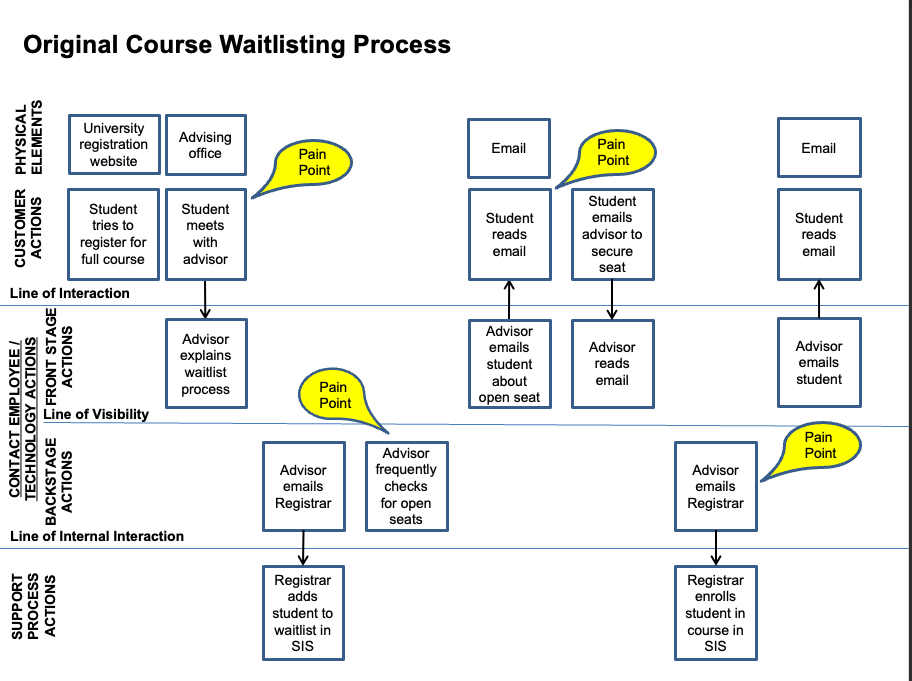Published on
Improving Student Outcomes Through Service Blueprinting

The Need for Improved College Student Experiences
There are compelling reasons to pursue excellent student experiences at a college or university. The first is to increase student satisfaction, which is an important output tied to retention. The second is to differentiate one university from another. Well-designed student experiences with less friction and more enjoyment offer an opportunity to stand out in the competitive college market. Although there are other customers in the higher education setting, the primary one is the student. Student affairs and auxiliary departments, in particular, play a key role in improving student satisfaction and retention. Also, many believe customer expectations have substantially increased since the pandemic, and the rising cost of tuition has led to prospective students seeking greater value.
Many higher education marketing departments use journey mapping to gain a better understanding of prospective student perceptions, but few other departments take a deep dive into how the institution’s interactions with students are received and can be improved. Service blueprinting is a very common technique that combines process mapping (the steps and flow of a process) and journey mapping (how the customer experiences the process).
What is a Service Blueprint?
While there are many other process mapping techniques, such as basic flowcharts, value stream maps, business process modeling notation, service blueprinting is simpler yet more complete. With roots in both service design and business process improvement, service blueprinting includes visually mapping all elements of a service experience. An important feature of service blueprinting is that it starts with the customer—or user—in mind. While internal parts of the process are important, the customer’s actions and perspective take precedence. Another unique feature of service blueprinting is the inclusion of physical and other sensory elements the customer experiences. These elements are important to understand the customer experience because people often make judgments about the quality of a service based not only on how a process flows but on what they see or sense. Service blueprinting is not a new technique; in fact, it has been in use for 40 years, primarily in thousands, if not millions, of for-profit organizations around the world. It has only recently found an audience in higher education.
Benefits of Service Blueprinting
There are many benefits to using service blueprinting, especially in a higher education context:
- Institutions interact with students in hundreds of ways, offering many opportunities for improved experience.
- Service blueprinting is primarily used to improve customer satisfaction and retention, which are key success metrics for institutions.
- Institutions are complex, often siloed organizations, and service blueprinting can serve as a silo buster.
- Service blueprinting initiatives can encourage employees to take on a more customer-focused perspective.
- The technique is simple to use, flexible and low cost.
Parts of a Typical Service Blueprint
Example of a service blueprint:

A traditional service blueprint includes*:
- Customer actions: First, lay out all steps the customer takes during the process.
- Front stage organizational actions (sometimes technology actions): Next, plot the steps staff members take or the technology interfaces visible to the customer.
- Backstage organizational actions: Next, add steps the same staff members take that are not visible to the customer.
- Support processes: Next, add any behind-the-scenes process (e.g., a course registration system registers a student for a class).
- Physical and sensory elements: For each customer action, note what the customer sees or senses (e.g., signage, buildings, attire).
Additional elements:
- Lines of interaction, visibility and internal interaction
- Arrows used to indicate interactions between processes
- Pain points and other areas for improvement
*NOTE: This technique is flexible and does not always include all parts. Practitioners may use whatever elements are useful in each case.
A service blueprint may be plotted on a whiteboard, with sticky notes or using a digital blueprinting template. To share and retain the blueprint, creating a final digital version is recommended.
Dialogue within the Mapping Process Prompts Solutions
Unlike many process improvement techniques, service blueprinting is a bottom-up approach that looks to students and employees for answers. The approach includes the voices of a variety of stakeholders involved in the process itself and requires dialogue and empathy among participants. For instance, a blueprint of a new student orientation event might include student-facing staff like admissions personnel, academic advisors, a student life event coordinator and a student representative. Survey data from the event may be used to gain a clearer understanding of the student perspective. The service blueprinting facilitator would bring this group together to map out the steps students take, then layer all actions the institution takes to complete the process. Once there is an agreed-upon understanding of all steps involved, physical and sensory elements like banners, signage and computer slides are layered on. As the exercise progresses, the service blueprinting team members are asked to identify pain points and other opportunities for improvement. Discussions about pitfalls within a process can sometimes lead to finger-pointing. Therefore, it is essential that the facilitator establish from the start that the blueprinting exercise is blame-free and that all involved have the same goal to improve the student experience—and, often as a byproduct, improve staff members’ experience.
While department directors are often included on service blueprinting teams, there is no expectation that they are the expert on how the process takes place; rather, those who are actually involved are empowered to share details about the existing process. In effect, leaders can learn from other team members and begin considering possible solutions to the pain points and opportunities for improvement that often lay more within their control.
Tracking Changes
As changes are implemented to address pain points and opportunities for improvement, they can be tracked using a scorecard. This scorecard can be shared regularly with the service blueprinting team to communicate to team members that their input informs change and to keep leaders accountable. Leaders can assign each pain point and opportunity for improvement a status (e.g., complete, in progress, not yet started, not pursuing) along with comments explaining the reason for the status. This transparent approach keeps everyone informed and on the same page as they implement changes.
Developing a Student-Centered Culture
Having studied the use of service blueprinting in higher education and used the technique himself, the author can attest to the power of the approach beyond merely improving individual processes. Any administrator wishing to produce a more student-centered mindset among their employees would do well to implement service blueprinting within their division or across their entire campus. The exercise reframes student-facing processes from an organizational perspective to a customer-centric one. Those involved in service blueprinting often continue to take on the customer’s perspective in other venues and help infuse this approach into other campus conversations. While this change may start in pockets, ultimately the larger university can become more student-centered.
Getting Started with Service Blueprinting
To facilitate a service blueprinting exercise, a facilitator need not hold an MBA or even be knowledgeable about the processes being mapped. Ideally, they are a neutral party who can promote participant engagement to paint a full picture of the student experience and the steps involved in a process. To effectively lead a service blueprinting exercise, a facilitator needs a basic understanding of the elements of a service blueprint as presented in this article. That said, there are many more resources available online, including the articles and templates provided below. Start with a common student process at your institution that you or a colleague believes has low satisfaction. Feel free to reach out to the author at will.roberts@methodistcollege.edu for more guidance on implementing a service blueprinting initiative at your campus.
Resources
Approachable articles/guides:
- Gaudet, G. & Ho, K. (2019, October 1). How to Create a Service Blueprinting Facilitation Guide. NavaPBC. https://www.navapbc.com/toolkits/service-blueprinting-facilitation-guide
- Roberts, J. W. (2022). Service Design in Student Affairs: Blueprinting the Student Experience. Innovative Higher Education, 47(3), 367–387. https://doi.org/10.1007/s10755-02109580-8
- Full article link: https://rdcu.be/cATMk
- Stephens, N. (2015, April 13). Examining the Student Experience Using Service Blueprinting”. Educause Review. https://er.educause.edu/articles/2015/4/examining-the-student-experience-using-service-blueprinting
Templates:
- ASU Center for Services Leadership free toolkit (includes templates): https://csl.wpcarey.asu.edu/events-programs/service-blueprinting/service-blueprinting-overview


